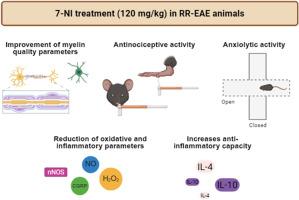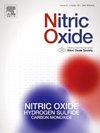7-硝基茚唑是一种nNOS抑制剂,在复发-缓解型多发性硬化症小鼠模型中可减少偏头痛样伤害感受、脱髓鞘和焦虑样行为。
IF 3.2
2区 生物学
Q2 BIOCHEMISTRY & MOLECULAR BIOLOGY
引用次数: 0
摘要
多发性硬化症(MS)是一种复杂的神经炎症性疾病,通常与偏头痛和焦虑有关,这两种疾病都会损害生活质量。MS病理涉及强烈的炎症和氧化过程,包括增加一氧化氮(NO)的产生。然而,NO在ms相关偏头痛症状中的作用尚不清楚。本研究评估了在复发缓解型实验性自身免疫性脑脊髓炎(RR-EAE)小鼠模型中,反复给药7-硝基茚唑(7-NI)(一种选择性神经性一氧化氮合酶(nNOS)抑制剂)是否可以缓解偏头痛样伤害感受、焦虑样行为和神经炎症生物标志物。以髓鞘少突胶质细胞糖蛋白(MOG35-55)和黄芪皂苷为佐剂,诱导雌性C57BL/6小鼠(20-30 g)产生RR-EAE。诱导后第20 ~ 35天,小鼠每天灌胃7-NI (120 mg/kg)。评估疾病进展、机械性/自发性异常性疼痛和焦虑样行为。在方案结束时,分析氧化和炎症生物标志物。7-NI治疗可显著降低疾病严重程度和伤害感受,发挥抗焦虑作用,并改善髓磷脂质量参数。抑制脑干、三叉神经节和血浆中氧化和亚硝化标志物(NOx、H2O2)的增加。治疗还可以防止血浆降钙素基因相关肽升高和抗炎细胞因子(IL-4, IL-10)的增加,提示RR-EAE中神经炎症的阳性调节。这些发现强调了7-NI在多发性硬化症中的治疗潜力;然而,需要进一步的研究来证实其在不同人群和慢性疾病背景下的安全性和有效性。本文章由计算机程序翻译,如有差异,请以英文原文为准。

7-Nitroindazole, an nNOS inhibitor, reduces migraine-like nociception, demyelination, and anxiety-like behavior in a mouse model of relapsing-remitting multiple sclerosis
Multiple sclerosis (MS) is a complex neuroinflammatory disease often associated with migraine and anxiety, both of which impair quality of life. MS pathology involves intense inflammatory and oxidative processes, including increased nitric oxide (NO) production. However, the role of NO in MS-related migraine symptoms remains unclear. This study evaluated whether repeated administration of 7-nitroindazole (7-NI), a selective neuronal nitric oxide synthase (nNOS) inhibitor, could alleviate migraine-like nociception, anxiety-like behavior, and neuroinflammatory biomarkers in a relapsing-remitting experimental autoimmune encephalomyelitis (RR-EAE) mouse model. RR-EAE was induced in female C57BL/6 mice (20–30 g) using myelin oligodendrocyte glycoprotein (MOG35-55) and Quillaja saponin as an adjuvant. Mice received daily intragastric 7-NI (120 mg/kg) from day 20–35 post-induction. Disease progression, mechanical/spontaneous allodynia, and anxiety-like behavior were assessed. At the end of the protocol, oxidative and inflammatory biomarkers were analyzed. 7-NI treatment significantly reduced disease severity and nociception, exerted an anxiolytic effect, and improved myelin quality parameters. It inhibited the increase of oxidative and nitrosative markers (NOx, H2O2) in the brainstem, trigeminal ganglion, and plasma. Treatment also prevented plasma calcitonin gene-related peptide elevation and increased anti-inflammatory cytokines (IL-4, IL-10), suggesting positive modulation of neuroinflammation in RR-EAE. These findings highlight the therapeutic potential of 7-NI in MS; however, further studies are required to confirm its safety and efficacy in different populations and chronic disease contexts.
求助全文
通过发布文献求助,成功后即可免费获取论文全文。
去求助
来源期刊

Nitric oxide : biology and chemistry
生物-生化与分子生物学
CiteScore
7.50
自引率
7.70%
发文量
74
审稿时长
52 days
期刊介绍:
Nitric Oxide includes original research, methodology papers and reviews relating to nitric oxide and other gasotransmitters such as hydrogen sulfide and carbon monoxide. Special emphasis is placed on the biological chemistry, physiology, pharmacology, enzymology and pathological significance of these molecules in human health and disease. The journal also accepts manuscripts relating to plant and microbial studies involving these molecules.
 求助内容:
求助内容: 应助结果提醒方式:
应助结果提醒方式:


